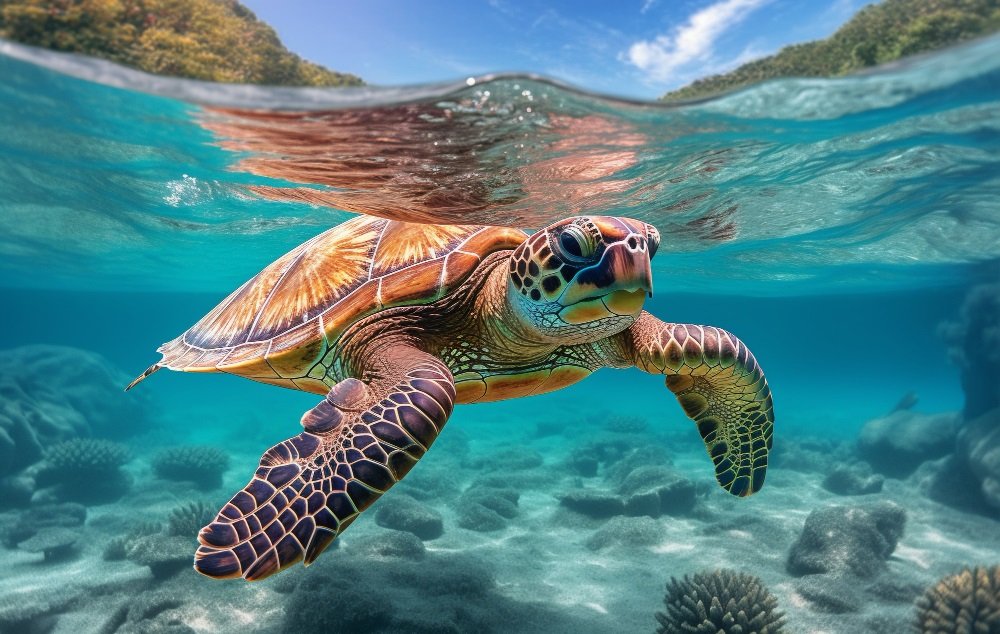Water turtles are a fascinating group of reptiles that have been a part of human culture for thousands of years. With their unique shells and gentle nature, it’s no wonder why they’re a popular pet among many. However, when it comes to caring for these amazing creatures, one of the most important aspects is their diet. What do water turtles eat, and how can you ensure they’re getting the nutrients they need to thrive?
What Do Water Turtles Eat?
Water turtles are omnivores, which means they eat both plant and animal matter. In the wild, they feed on a variety of foods including aquatic plants, insects, crustaceans, and even small fish. As pets, it’s essential to provide a balanced diet that mimics their natural diet as closely as possible.
Aquatic Plants
Aquatic plants are an essential part of a water turtle’s diet. They provide essential vitamins and minerals, as well as fiber and other nutrients. Some examples of aquatic plants that are safe for water turtles to eat include duckweed, water hyacinth, and anacharis. It’s important to note that not all aquatic plants are safe for water turtles, so it’s crucial to do your research and only feed them plants that are specifically recommended for their diet.
Insects and Crustaceans
Insects and crustaceans are another important source of protein for water turtles. Live or frozen/freeze-dried insects such as crickets, mealworms, and waxworms are all great options. You can also feed your water turtle crustaceans like shrimp or snails. Just be sure to gut-load the insects and crustaceans with nutritious foods before feeding them to your turtle.
Fruits and Vegetables
Fruits and vegetables can also be a great addition to a water turtle’s diet. Some examples of fruits and vegetables that are safe for water turtles to eat include kale, collard greens, and squash. Just be sure to remove any seeds or pits, as they can be a choking hazard. You can also offer your water turtle commercial pellets or sticks specifically formulated for their diet.
What Not to Feed Your Water Turtle
While it may be tempting to feed your water turtle a variety of foods, there are some things you should avoid feeding them altogether. Never feed your water turtle raw or undercooked meat, as it can be contaminated with bacteria. You should also avoid feeding them processed foods like bread or cereal, as they can cause digestive problems. Additionally, never feed your water turtle wild-caught fish or other aquatic animals, as they can carry diseases and parasites.
Conclusion
Providing a balanced and nutritious diet is essential for the health and well-being of your water turtle. By offering a variety of foods including aquatic plants, insects, crustaceans, fruits, and vegetables, you can help ensure your turtle is getting all the nutrients they need to thrive. Remember to always do your research and only feed your water turtle foods that are specifically recommended for their diet. With a little planning and creativity, you can provide your water turtle with a diet that’s both delicious and nutritious.
What Does a Water Turtle Eat?
Water turtles are fascinating creatures that have been a part of human culture for centuries. They are known for their distinctive shells, slow movements, and unique eating habits. In this article, we will delve into the world of water turtles and explore what they eat. (See Also: What To Do Turtles Eat)
What is the Diet of a Water Turtle?
The diet of a water turtle consists of a variety of foods, including plants, animals, and even fungi. In the wild, water turtles are omnivores, which means they eat both plant and animal matter. In captivity, water turtles can be fed a diet that consists of a combination of the following:
- Leafy greens such as kale, collard greens, and mustard greens
- Fruits such as berries, melons, and bananas
- Insects such as crickets, mealworms, and waxworms
- Commercial turtle pellets
- Frozen or live foods such as brine shrimp and bloodworms
It’s important to note that water turtles have specific nutritional needs, and their diet should be tailored to meet those needs. A balanced diet that includes a variety of foods can help ensure the health and well-being of a water turtle.
What Foods Should Avoid Feeding to Water Turtles?
While water turtles are omnivores, there are certain foods that should be avoided when feeding them. These foods can be harmful or even toxic to water turtles, and can cause a range of health problems. Some examples of foods that should be avoided include:
- Raw or undercooked meat
- High-protein foods such as fish and shrimp
- Foods high in salt, such as processed foods and table salt
- Foods high in sugar, such as candy and baked goods
- Foods that are high in fat, such as fried foods and processed snacks
It’s also important to avoid feeding water turtles foods that are high in calcium, such as bones and shells. These foods can cause a range of health problems, including kidney stones and shell rot.
How Often Should Water Turtles Be Fed?
The frequency of feeding a water turtle depends on a range of factors, including the turtle’s age, size, and activity level. In general, young water turtles require more frequent feeding than older turtles, and turtles that are active and growing quickly may require more food than those that are sedentary and mature.
As a general rule, water turtles should be fed 2-3 times a week, with a variety of foods offered at each meal. It’s also important to provide a source of fresh water and a basking area where the turtle can warm up and dry off.
What are the Best Foods for Water Turtles?
Water turtles are unique animals with specific nutritional needs. When choosing foods for a water turtle, it’s important to select foods that are high in protein, low in fat, and rich in nutrients. Some examples of foods that are well-suited for water turtles include: (See Also: How Many Gallons Do Turtles Need)
| Foods | Benefits |
|---|---|
| Leafy greens | High in fiber, low in calories |
| Fruits | High in antioxidants, low in calories |
| Insects | High in protein, low in fat |
| Commercial turtle pellets | Formulated to meet the nutritional needs of water turtles |
It’s also important to provide a source of calcium for water turtles, as this mineral is essential for shell growth and development. Foods such as dark leafy greens, such as kale and collard greens, are rich in calcium and can be offered as a treat.
Conclusion
Water turtles are fascinating creatures that require a specific diet to thrive. By providing a balanced diet that includes a variety of foods, you can help ensure the health and well-being of your water turtle. Remember to avoid feeding foods that are high in salt, sugar, and fat, and to provide a source of calcium to support shell growth and development. With the right diet and proper care, your water turtle can live a long and healthy life.
Recap
In this article, we explored the diet of water turtles, including the foods they eat and the foods they should avoid. We also discussed the importance of providing a balanced diet that meets the nutritional needs of water turtles, and offered some tips for choosing the best foods for your pet. By following the guidelines outlined in this article, you can help ensure the health and well-being of your water turtle.
Key points to remember:
- Water turtles are omnivores and require a balanced diet that includes a variety of foods
- Foods high in salt, sugar, and fat should be avoided
- Foods high in calcium, such as dark leafy greens, are essential for shell growth and development
- Commercial turtle pellets can be used as a staple food
- Fresh water and a basking area are essential for water turtles
By following these guidelines, you can help ensure the health and well-being of your water turtle and provide it with a long and happy life.
Here are five FAQs related to “What Does Water Turtles Eat”:
Frequently Asked Questions: What Does Water Turtles Eat?
Q: What is the primary source of nutrition for water turtles?
Water turtles are primarily carnivores, which means they eat meat. Their diet consists mainly of aquatic plants, fruits, and insects. In the wild, they feed on snails, worms, and other invertebrates. In captivity, they can be fed a diet of commercial pellets, leafy greens, and occasional treats like fruits and vegetables. (See Also: Can Aquatic Turtles Be Out Of Water)
Q: Can water turtles eat commercial pellets as their main source of nutrition?
While commercial pellets can be a convenient and nutritious option for water turtles, they should not be their main source of nutrition. A balanced diet that includes a variety of foods, such as leafy greens, fruits, and insects, is essential for maintaining good health and preventing nutritional deficiencies. Pellets should be used as a supplement, not as the primary source of nutrition.
Q: Can I feed my water turtle live or frozen/freeze-dried foods?
Yes, live or frozen/freeze-dried foods can be a great way to provide variety and nutrition to your water turtle. Live foods like earthworms, crickets, and snails can be a fun and stimulating treat for your turtle. Frozen/freeze-dried foods like brine shrimp, bloodworms, and daphnia can also be a nutritious addition to their diet. However, make sure to thaw frozen foods properly and remove any bones or shells before feeding.
Q: How often should I feed my water turtle?
The frequency of feeding depends on the age, size, and species of your water turtle. Baby turtles, for example, require more frequent feeding than adult turtles. A general rule of thumb is to feed your turtle as much as they can consume within a few minutes, and then remove any leftover food to prevent overfeeding and maintain good water quality.
Q: Can I feed my water turtle vegetables and fruits?
Yes, water turtles can eat certain vegetables and fruits as a treat or supplement to their diet. Leafy greens like kale, collard greens, and mustard greens are a great source of fiber and nutrients. Fruits like berries, melons, and bananas can also be a tasty and nutritious treat. However, make sure to remove any seeds, pits, or rinds, and only feed them in moderation to prevent digestive issues.


